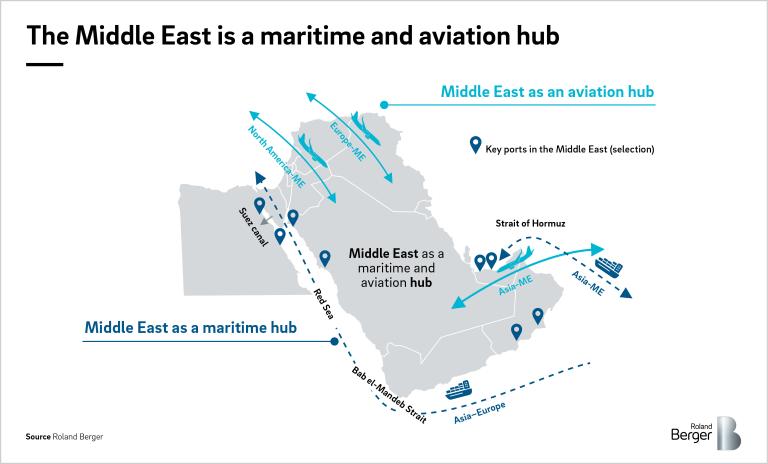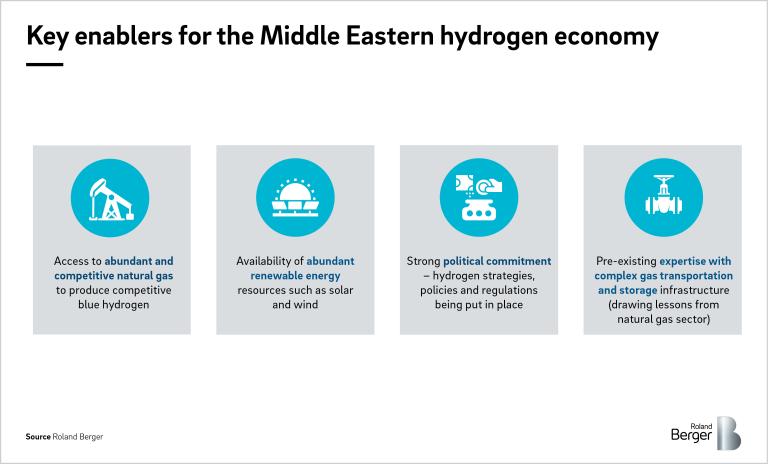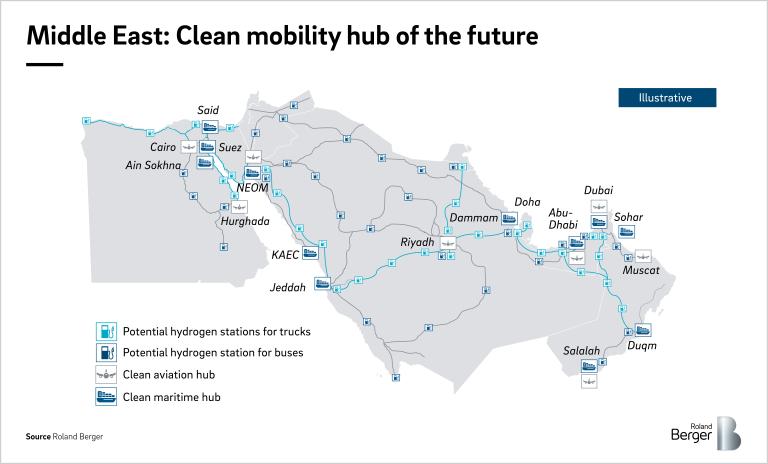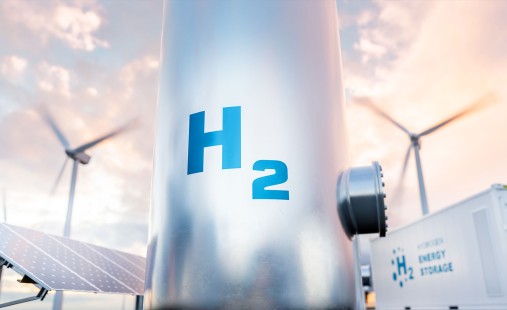Outlining the key challenges and identifying the key enablers to drive the low carbon hydrogen ecosystem forward in the Middle East.


Hydrogen: Powering the Future of Mobility in The Middle East
The Middle East has abundant and competitive natural gas and renewable energy resources that position it well to fuel the sustainable mobility revolution.
Roland Berger is launching a new four-part series called "Hydrogen: Powering the Future of Mobility in the Middle East." This series aims to shed light on hydrogen's decarbonization potential and its role in reducing carbon emissions in the region’s mobility sector.
The first part of the series outlines how hydrogen can be used to decarbonize the mobility sector and why we believe this is an opportunity for the Middle East. The following parts will evaluate the use of hydrogen in the maritime, aviation, and road logistics sectors, respectively.
- Part 1: Overview of hydrogen use in the mobility sector in the Middle East
- Part 2: Hydrogen use in the maritime sector in the Middle East
- Part 3: Hydrogen use in the aviation sector in the Middle East
- Part 4: Hydrogen use in heavy-duty road transport in the Middle East

Most Middle Eastern countries have outlined their net-zero targets and are formulating plans to achieve those targets. Given the high contribution of the mobility sector to rising emissions, the sector is a core focus of emission reduction endeavors.
Total GHG emissions in the Middle East have almost doubled in the last 20 years and continue to rise steadily. Around 16% of these emissions can be attributed to the mobility sector, including road, domestic aviation. In addition to this domestic burden, the Middle East accounts for a significant portion of the emissions from international shipping and air travel.
Owing to its strategic geographic location, the region serves as a natural passage for a large chunk of global maritime and aviation cargo and passenger traffic. As a maritime hub, more than 10% of all global trade passes through the Strait of Hormuz and the Bab El-Mandeb. Over 40% of global container capacity passes through the Red Sea and the Suez Canal. In 2020, the Middle East accounted for 17% of global air passenger traffic and 15% of global air freight. This strategic location is an ideal place for ships and planes to refuel, making the region an optimal place to push for decarbonization.
While electrification is suitable for decarbonizing smaller vehicle types, hydrogen is currently a very trustworthy approach to decarbonize heavy-duty modes of transportation like aircraft, ships, trucks, and buses. Road transport can use hydrogen or derived e-fuels like e-CNG and e-MeOH; trains can utilize hydrogen fuel cells; aircraft can use hydrogen or e-kerosene; and maritime sector can use green ammonia or methanol for deep water vessels.
The Middle East is well-positioned to be at the forefront of the hydrogen revolution, including for mobility
The Middle East region, with its abundant natural gas and renewable energy resources, is well positioned to achieve significant economies of scale and fuel the hydrogen revolution. The region is committed to hydrogen, with several countries on the verge of launching hydrogen strategies and policies. Its experience with complex gas transportation and storage is an added bonus.

Hydrogen has the potential to be a game changer if challenges are overcome
The Middle East is betting big on hydrogen, and the reason is well-founded. Multiple demonstration and pilot projects are currently underway across the mobility sphere, in key countries such as Saudi Arabia, the UAE, Oman, and Egypt. These small-scale projects are bringing to light key challenges around large-scale deployment of hydrogen in mobility. While the Middle East region is well placed to develop a hydrogen ecosystem, it needs to deploy key enablers to overcome the outlined challenges and increase adoption of low carbon hydrogen across the mobility sector.
The biggest challenges facing hydrogen use in mobility sector, along with their corresponding key enablers, are stated below:
- Inadequate hydrogen supply leading to high cost: green hydrogen production is still ramping up, with most projects in pilot or demonstration stage. Since economies of large-scale plants are yet to be realized in green hydrogen production, there is a significant gap between the price that producers are willing to accept for low-carbon hydrogen and what consumers are willing to pay.
- Proliferation of large-scale projects would help overcome the challenge by lowering cost of production. Developing comprehensive regulations and hydrogen valleys, providing fiscal and economic support to hydrogen projects, and putting in place key enablers such as a robust certification scheme, technical standards and permitting regime are key to building a hydrogen ecosystem.
- Inadequate deployment infrastructure: There is lack of a hydrogen deployment infrastructure network with insufficient fueling stations for buses and trucks; hydrogen bunkering infrastructure at ports remains nonexistent; and very few global airports boast permanent SAF supplies. This chicken or egg problem can be alleviated by setting targets for developing clean mobility infrastructure. In addition, introducing clarity around supporting standards and permitting regimes, along with ensuring collaboration between various public and private entities, will aid faster development of infrastructure.
- Nascent technology: Many of the mobility technologies that use hydrogen or its derivatives are in development or in the prototype stage and have not been fully commercialized (e.g., fuel cell aircraft and ammonia vessels). Funding R&D initiatives, establishing country-level technology transfer agreements and deploying pilot projects to test technology are all key to advancing technologies along the hydrogen value chain.
- Unclear regulations and incentives for adoption: The absence of sector-specific decarbonization targets and a lack of incentives for hydrogen adoption, are slowing the proliferation of hydrogen-based clean fuel technologies. Developing detailed sector-specific decarbonization targets and deploying mechanisms and incentives such as carbon markets will help increase low carbon hydrogen adoption

"Middle Eastern countries could become clean mobility hubs with a mix of clear regulations, strong incentive schemes and innovation commitment."
Hydrogen has the potential to be a game changer if challenges are overcome
Once key enablers are put in place, the Middle East region has the potential to become a clean mobility hub that promotes emission-free transportation across road, maritime and aviation. While the opportunity is big, the window of action is small as first-mover countries will have a considerable advantage in securing their place in the growing global market for clean fuels.
Given its central location between Europe, Asia, and Africa, the Middle East could become a crucial hub for airlines looking to refuel with hydrogen or SAF (e.g., e-kerosene). The region is also at the center of multiple busy shipping routes, creating an opportunity for key ports to offer clean bunkers to global liners.
As the primary means for passenger and goods transport, road logistics is vital for countries in the region. Setting up hydrogen refueling stations along key logistics routes between countries in the Middle East will significantly cut emissions from road transportation and serve as a "hydrogen corridor" for trucks, buses, and possibly even smaller vehicles.

The Middle East has good prerequisites to become a clean mobility hub that champions the use of low carbon hydrogen. Part II of the series: "Hydrogen: Decarbonizing the Maritime Sector" will shed light on hydrogen's role in reducing emissions from the maritime sector.


